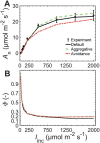The role of chloroplast movement in C4 photosynthesis: a theoretical analysis using a three-dimensional reaction-diffusion model for maize
- PMID: 37083863
- PMCID: PMC10400148
- DOI: 10.1093/jxb/erad138
The role of chloroplast movement in C4 photosynthesis: a theoretical analysis using a three-dimensional reaction-diffusion model for maize
Abstract
Chloroplasts movement within mesophyll cells in C4 plants is hypothesized to enhance the CO2 concentrating mechanism, but this is difficult to verify experimentally. A three-dimensional (3D) leaf model can help analyse how chloroplast movement influences the operation of the CO2 concentrating mechanism. The first volumetric reaction-diffusion model of C4 photosynthesis that incorporates detailed 3D leaf anatomy, light propagation, ATP and NADPH production, and CO2, O2 and bicarbonate concentration driven by diffusional and assimilation/emission processes was developed. It was implemented for maize leaves to simulate various chloroplast movement scenarios within mesophyll cells: the movement of all mesophyll chloroplasts towards bundle sheath cells (aggregative movement) and movement of only those of interveinal mesophyll cells towards bundle sheath cells (avoidance movement). Light absorbed by bundle sheath chloroplasts relative to mesophyll chloroplasts increased in both cases. Avoidance movement decreased light absorption by mesophyll chloroplasts considerably. Consequently, total ATP and NADPH production and net photosynthetic rate increased for aggregative movement and decreased for avoidance movement compared with the default case of no chloroplast movement at high light intensities. Leakiness increased in both chloroplast movement scenarios due to the imbalance in energy production and demand in mesophyll and bundle sheath cells. These results suggest the need to design strategies for coordinated increases in electron transport and Rubisco activities for an efficient CO2 concentrating mechanism at very high light intensities.
Keywords: 3D leaf anatomy; Biophysical model; CO2 concentrating mechanism; chloroplast movement; gas exchange; leakiness; ray tracing.
© The Author(s) 2023. Published by Oxford University Press on behalf of the Society for Experimental Biology.
Conflict of interest statement
The authors declare they have no conflict of interest.
Figures




Similar articles
-
A two-dimensional microscale model of gas exchange during photosynthesis in maize (Zea mays L.) leaves.Plant Sci. 2016 May;246:37-51. doi: 10.1016/j.plantsci.2016.02.003. Epub 2016 Feb 6. Plant Sci. 2016. PMID: 26993234
-
Aggregative movement of C4 mesophyll chloroplasts is promoted by low CO2 under high intensity blue light.Plant Biol (Stuttg). 2023 Jun;25(4):563-570. doi: 10.1111/plb.13512. Epub 2023 Mar 10. Plant Biol (Stuttg). 2023. PMID: 36790102
-
The coordination of C4 photosynthesis and the CO2-concentrating mechanism in maize and Miscanthus x giganteus in response to transient changes in light quality.Plant Physiol. 2014 Mar;164(3):1283-92. doi: 10.1104/pp.113.224683. Epub 2014 Jan 31. Plant Physiol. 2014. PMID: 24488966 Free PMC article.
-
Bundle-sheath leakiness in C4 photosynthesis: a careful balancing act between CO2 concentration and assimilation.J Exp Bot. 2014 Jul;65(13):3443-57. doi: 10.1093/jxb/eru157. Epub 2014 Apr 22. J Exp Bot. 2014. PMID: 24755278 Review.
-
How Light Reactions of Photosynthesis in C4 Plants Are Optimized and Protected under High Light Conditions.Int J Mol Sci. 2022 Mar 26;23(7):3626. doi: 10.3390/ijms23073626. Int J Mol Sci. 2022. PMID: 35408985 Free PMC article. Review.
Cited by
-
Creating a virtual leaf.AoB Plants. 2023 Jun 4;15(3):plad033. doi: 10.1093/aobpla/plad033. eCollection 2023 Jun. AoB Plants. 2023. PMID: 37334264 Free PMC article. Review.
-
Genomic and Transcriptomic Insights into the Evolution of C4 Photosynthesis in Grasses.Genome Biol Evol. 2024 Aug 5;16(8):evae163. doi: 10.1093/gbe/evae163. Genome Biol Evol. 2024. PMID: 39066653 Free PMC article.
-
Shining light on photosynthesis.J Exp Bot. 2025 Aug 21;76(12):3243-3246. doi: 10.1093/jxb/eraf096. J Exp Bot. 2025. PMID: 40378050 Free PMC article. No abstract available.
-
Effects of high light intensity and spectral variability on maize photosynthesis and growth.Front Plant Sci. 2025 Mar 26;16:1511768. doi: 10.3389/fpls.2025.1511768. eCollection 2025. Front Plant Sci. 2025. PMID: 40206882 Free PMC article.
References
-
- Aernouts B, Watté R, Van Beers R, Delport F, Merchiers M, De Block J, Lammertyn J, Saeys W.. 2014. Flexible tool for simulating the bulk optical properties of polydisperse spherical particles in an absorbing host: experimental validation. Optics Express 22, 20223–20238. - PubMed
-
- Allen WA, Gausman HW, Richardson AJ.. 1973. Willstätter-Stoll theory of leaf reflectance evaluated by ray tracing. Applied Optics 12, 2448–2453. - PubMed
-
- Bauwe H. 1986. An efficient method for the determination of Km values for HCO3 −of phosphoenolpyruvate carboxylase. Planta 169, 356–360. - PubMed
Publication types
MeSH terms
Substances
Associated data
LinkOut - more resources
Full Text Sources
Other Literature Sources
Miscellaneous

